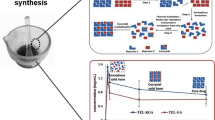Abstract
The thermal decomposition of capecitabine (CAP) was measured with thermogravimetry, differential scanning calorimetry, and thermogravimetric analysis coupled with Fourier transform infrared spectroscopy. The IR spectra, high-performance liquid chromatography, and liquid chromatography–mass spectrometry of CAP and the residue of its thermal decomposition at various temperatures were determined. The molecular bond orders were calculated using an ab initio method from the GAMESS program of quantum chemistry. The mode of thermal decomposition for CAP was discussed. The kinetic parameters for thermal decomposition such as activation energy E a and the pre-exponential factor A were obtained using the Ozawa method. The prospective lifetime of CAP was estimated using the Dakin equation. The results indicated that the thermal decomposition of CAP is a three-step process, and the first mass loss stage is to lose pentyl formate. The initial decomposition temperature in either nitrogen or air is 120 °C. For decomposition in nitrogen, the E a and A for the initial thermal decomposition are 105.1 kJ mol−1 and 9.12 × 1011 min−1, respectively. For decomposition in air, the corresponding E a and A are 105.1 kJ mol−1 and 9.55 × 1011 min−1, respectively. The CAP has poor thermal stability under routine temperature.










Similar content being viewed by others
References
Rossi S, editors. Australian Medicines Handbook (2013 ed.). Adelaide: The Australian Medicines Handbook Unit Trust. 2013.
Cunningham D, Coleman R. New options for outpatient chemotherapy the role of oral fluoropyrimidines. Cancer Treat Rev. 2001;27:211–20.
Leonard R, Hennessy BT, Blum JL, O’Shaughnessy J. Dose-adjusting capecitabine minimizes adverse effects while maintaining efficacy: a retrospective review of capecitabine for metastatic breast cancer. Clin Breast Cancer. 2011;11(6):349–56.
Sharma SP. Capecitabine and irinotecan in advanced gastric cancer. Lancet Oncol. 2007;8(7):577.
Li B, Yan J, Zhou T, Wang Z, Li H, Sun H. A phase I study of concurrent late course accelerated hyper-fractionated radiotherapy and capecitabine and cisplatin for local advanced esophageal cancer. Int J Radiat Oncol. 2008;72(1):S283.
Shimma N, Umeda I, Arasaki M, Murasaki C, Masubichi K, Kohchi Y, Miwa M, Ura M, Sawada N, Tahara H, Kuruma I, Horii I, Ishitsuka H. The design and synthesis of a new tumor-selective fluoropyrimidine carbamate, capecitabine. Bioorg Med Chem. 2000;8(7):1697–706.
Tao YT, Zhan D, Zhang KL. Kinetics of thermal decomposition of racecadotril in air. Acta Chim Sin. 2006;64(5):435–8 (in Chinese).
Zhang J, Sheng RL, Mai WP. Studies on the thermal decomposition process and kinetics of purine drugs. Acta Pharm Sin. 2002;3(7–8):644–8 (in Chinese).
Wang XJ, You JZ. Thermal decomposition mechanism and kinetics of stavudine. Chin J Appl Chem. 2011;28(6):709–15 (in Chinese).
Rompay JV. Purity determination and evaluation of new drug substances. J Pharm Biomed Anal. 1986;4:725–32.
Giron D, Goldbronn C. Use of DSC and TG for identification and quantification of the dosage form. J Therm Anal. 1997;48:473–83.
Silva ACM, Ga´lico DA, Guerra RB, Perpe´tuo GL, Legendre AO, Rinaldo D, Bannach G. Thermal stability and thermal decomposition of the antihypertensive drug amlodipine besylate. J Therm Anal Calorim. 2015;120:889–92.
Łaszcz M, Trzcińska K, Filip K, Szyprowska A, Mucha M, Krzeczyński P. Stability studies of capecitabine. J Therm Anal Calorim. 2011;105:1015–21.
Davoudi ET, Noordin MI, Javar HA, Kadivar A, Ashjari M, Chermahini SH. Stability study of the gastric floating dosage form of capecitabine. J Therm Anal Calorim. 2014;115:2495–9.
Schmidt MW, Baldridge KK, Boatz JA, Elbert ST, Gordon MS, Jensen JJ, Koseki S, Matsunaga N, Nguyen KA, Su S, Windus TL, Dupuis M, Montgomery JA. General atomic and molecular electronic structure system. J Comput Chem. 1993;14:1347–63.
Alexeev Y, Mazanetz MP, Ichihara O, Fedorov DG. GAMESS as a free quantum-mechanical platform for drug research. Curr Top Med Chem. 2012;12(18):2013–33.
American Society for Testing and Materials. ASTM E1641-99. 1999. http://www.astm.org/DATABASE.CART/HISTORICAL/E1641-99.htm.
Ozawa T. A new method of analyzing thermogravimetric data. Bull Chem Soc Jpn. 1965;38:1881–6.
Flynn JH, Wall LA. A quick direct method for the determination of activation energy from thermogravimetric data. J Polym Sci B. 1966;4:323–8.
The United States Pharmacopeial Convention. Capecitabine. The 35th revision of the United States Pharmacopeia/National Formulary (USP 35-NF30). Washington, 2011;2469–71.
Xie JX, Chang JB, Wang XM. Applications of infrared spectroscopy in organic chemistry and medicinal chemistry. Beijing: Science Press; 2001 (in Chinese).
NIST Chemistry Webbook Standard Reference Database, 2011, 69 release. http://webbook.nist.gov/chemistry
Fulias A, Vlase G, Grigorie C, Ledet¸i I, Albu P, Bilanin M, Vlase T. Thermal behaviour studies of procaine and benzocaine part 1: kinetic analysis of the active substances under non-isothermal conditions. J Therm Anal Calorim. 2013;113:265–71.
Amorim PHO, Ferreira APG, Machado LCM, Cervini P, Cavalheiro ETG. Investigation on the thermal behavior of b-blockers antihypertensives atenolol and nadolol using TG/DTG, DTA, DSC, and TG–FTIR. J Therm Anal Calorim. 2015;120:1035–42.
Dakin TW. Electrical insulation deterioration treated as a chemical rate phenomena. AIEE Trans Part I Commun Electron. 1948;67:113–22.
Zhang LJ, Pang JX, Bai JH. Thermogravimetry study of the lifetime of azithromycin. J Hebei NormaI Univ (Nat Sci Ed). 2001;25(4):488–9 (in Chinese).
Acknowledgements
This study was financially supported by Zhejiang Provincial Government of China (No. 2011C11032) and Zhejiang International Studies University (No. 07029005).
Author information
Authors and Affiliations
Corresponding author
Rights and permissions
About this article
Cite this article
Wang, Xj., You, Jz. Study on the thermal decomposition of capecitabine. J Therm Anal Calorim 123, 2485–2497 (2016). https://doi.org/10.1007/s10973-015-4857-9
Received:
Accepted:
Published:
Issue Date:
DOI: https://doi.org/10.1007/s10973-015-4857-9




